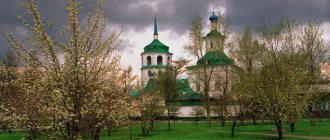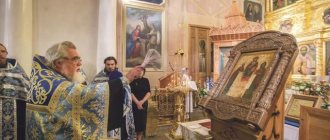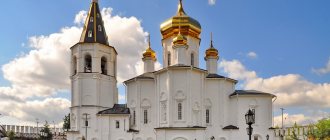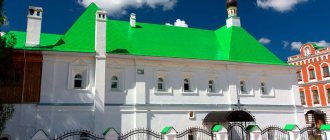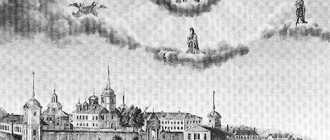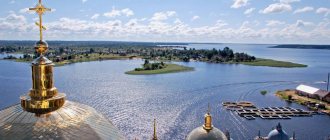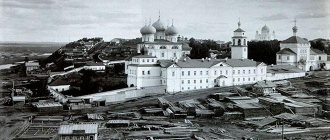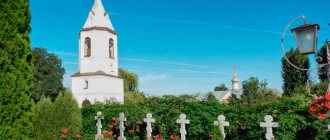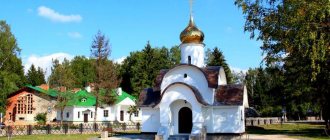The Orthodox Church is located on the territory of the Kursk Znamenskaya Monastery. The building was built in the period from 1816 to 1826, its foundation is associated with the memory of the events of the Patriotic War that happened in 1812. The Znamensky Church was created according to the canons of architectural classicism using the traditions of the European Renaissance. For a long period of time, a procession of the cross took place from the church with the transfer of the miraculous icon of the Most Pure Mother of God “The Sign”. Over the course of its long history, the building has undergone dramatic reconstructions. Today it is a cathedral and an architectural monument.
History of construction
Initially, on the site where the temple stands today, there was a Kursk fortress. During the Time of Troubles, the city was captured and ravaged by Polish troops led by Hetman Zolkiewski. The only building that managed to avoid an evil fate was this fortress. The people who escaped death thanked the Mother of God for her help and vowed to build a monastery in honor of the “Sign” icon.
Cathedral of the Icon of the Mother of God “The Sign” in Kursk
- In 1615, a wooden chapel was built near the fortress moat, consecrated in honor of the Nativity of the Blessed Virgin. Soon, Tsar Michael ordered the return to Kursk of the “Sign” shrine, which in 1618 ended up in the Nativity Monastery.
- In 1649, ruler Alexei Mikhailovich issued a decree on the construction of a new stone church on the site of a dilapidated wooden one. Construction was completed only three decades later; the project was financed by the state treasury and the support of private individuals. The newly-minted cathedral was consecrated in honor of the “Sign” icon. One of the chapels of the church was given the name of St. Alexis, the other - the great patron D. Thessalonica.
- In 1688, a grandiose bell was presented to the cathedral, which served for about 200 years. In the middle of the 18th century, craftsmen plastered the external and internal walls, and instead of one dome, they installed five. In 1771, the main altar was decorated with gilded copper with the plot of the Passion, and the iconostases were redecorated with new colors. In 1815, after expert inspections, the dilapidated structure had to be dismantled.
New life for the temple
The Znamensky Cathedral was built over the course of ten years; its foundation was directly connected with the memory of the events of the Patriotic War of 1812. The work was led by Archimandrite Palladius, a former officer, and the architect P. Schmit. Money for the construction was collected from the income of the Mother of God monastery, donations from citizens, merchants and nobles. The best Moscow and Kaluga masons took part in the construction; the architect A. Melnikov was called the author of the project.
- In 1816, workers dug a pit and laid a stone foundation; materials were collected in the winter, and construction continued in the spring. In 1826, the construction of the Znamensky Cathedral was completed. A refectory room and two bell towers were added to the cubic building from the west.
- The consecration took place in the same year, three days after the solemn ritual, the ashes of Alexander I were brought here. In 1832, a cast-iron iconostasis was installed in the church, which was created over the course of six years. In 1852, a chapel was installed in the lower church; the entrance galleries were formed by combining porticoes and passages.
- In 1865, regular restoration work was carried out in the cathedral, as a result of which the second tier of the building was abolished. A year later, three bells, differing in their dimensions, were raised to the bell tower. The outer walls of the building were painted blue and gray with white elements.
- During the Easter celebrations of 1883, Righteous John of Kronstadt celebrated the liturgy here. Nicholas II visited the Znamensky Cathedral twice: the first time in 1902, when he participated in military exercises near Kursk, the second time in 1914, moving to the Caucasus to join the army.
Interior of the Znamensky Temple
Before the revolution, the internal walls of the building were decorated with plaster and decorated with half-columns, as well as various stucco moldings on evangelical themes. The main altar was dedicated to the sacred icon of the Sign. Church aisles were located on the south and north of the building. A three-altar church was built above the refectory, consecrated to the glory of the Presentation of the Lord. The royal doors, like the iconostasis, were made of cast iron and gilded. The main shrine was kept in a silver icon case, in front of it was a velvet cloth embroidered with jewels. In the middle of the cathedral stood the bishop's pulpit.
On a note! Tsar Feodor in 1598 presented the temple with a richly decorated golden chasuble for the main church shrine. The Cathedral of the Sign also contained state charters, a Gospel written on special paper, a heavy silver chandelier, an icon of the Archangel Michael, as well as holy images created during the Crimean War.
History of the post-revolutionary period
The Orthodox community led the temple until 1932. In 1918, the main shrine was stolen from the building; an appeal to the authorities for help in investigating the case did not bring any results. The Znamenskaya relic was accidentally discovered by two playing girls in an ancient well, which, as legend says, was dug by Theodosius of Pechersk. The precious chasuble framing the image could not be found; the original gold frame was replaced with a simple silver one, enameled with blue paint. In 1920, the Root Shrine left the USSR.
- In 1932, the Bolshevik authorities issued a decree on the complete liquidation of the church parish, and a sound cinema was organized in the church. Soon, reconstruction was carried out, which significantly distorted the original shape of the building. In 1935, four domes and two bell towers were removed, and a year later the fence was removed. The main dome was saved thanks to the intervention of the city newspaper.
- The cinema, for which the reconstruction was carried out, opened in 1937, the viewing room was located in the center of the building, projectors were placed in the altar area, and a dance hall was organized below.
- During the Second World War, all film equipment was stolen by the German invaders, who set the building on fire during their retreat in 1943. Almost the entire interior of the building burned down, the dome and ceilings partially collapsed, the decoration and painting were also destroyed. After the liberation of the city from the enemy, a food warehouse was organized in the Znamensky Cathedral, and then a concentration camp for prisoners of war. A little later, an equipment warehouse and various workshops for the production of plastics and metal were installed here. However, the plant management abandoned the building in 1948, and the building was again transferred to the film department.
- In 1956, another reconstruction came to an end, which again distorted the architecture of the building. A two-tier foyer was installed in the center of the temple, a huge crystal chandelier was hung, large staircases were built at the entrance, upper and lower viewing rooms were organized, and a meeting room was created in the eastern part of the church. The cinema was very popular among citizens.
On a note!
In 1989, there was a big explosion in the cathedral; arriving ministers and law enforcement officers discovered colossal destruction, but the “Sign” icon was not damaged at all. The next morning, many pilgrims gathered in front of the temple gates and took direct part in the akathist about the divine salvation of the main relic. Those involved in the assassination attempt were arrested two years later; they admitted that they had committed a terrorist attack in order to weaken faith in the icon of the Most Pure Mother of God. The criminals did not want human casualties, so they set the explosive clock to 1:30 am.
New time
The return of the Znamenskaya Church of the Russian Orthodox Church took place in 1992; the following year the community received as a gift a copy of the miraculous Root Image “The Sign,” written and consecrated at the beginning of the 20th century.
Kursk Root Icon of the Mother of God “The Sign”
- In 1999, intensive reconstruction of the cathedral, which had suffered from numerous alterations, began. In just a few months, we managed to get rid of the false dome, columns, and unnecessary ceilings. In 2000, workers restored four domes and semi-columns, strengthened the crosses, and covered the roof with copper. The main altar was consecrated in the fall of the same year.
- In 2001, the first icons created by St. Petersburg artists were installed. In the east of the building, new chapels and vestibules framed with granite were installed, and balconies were built for the choirs. Soon the construction of the bell tower and refectory was completed.
- The artistic painting of the altar was completed in 2004. The faces of the great Christian saints were now displayed on the windows. A large chandelier was installed under the dome. The walls of the building and the bell tower were plastered in 2004. In the summer, the relics of Seraphim of Sarov were brought to the Church of the Sign, which were venerated for four days.
- In 2007, Metropolitan Laurus held an all-night vigil in the cathedral. In the fall of 2009, the original Znamenskaya Icon of the Most Pure Mother of God arrived at the church from abroad. In 2009 and 2013, the monastery was visited first by the President, and then by the Chairman of the Government of the Russian Federation D. Medvedev.
Kursk residents' discovery of a miraculous icon
According to ancient legend, Kursk, which was completely destroyed by the Tatars, was given a shrine by the Lord - the miraculous icon of the Sign of the Most Holy Theotokos. Prince Vasily Shemyaka, amazed by the miracles emanating from the miraculous image, founded a temple in honor of the found icon and moved it there many times. But every time the icon ended up again at the forest stream - at the place where it was found! The image was lost many times, was abused by the Tatars, was found again and continued to work miracles. The people believed that it was thanks to him that Kursk was reborn from the ashes after several centuries of complete decline and oblivion.
In 1597, Tsar Fyodor Ioannovich ordered the icon of the Sign of the Most Holy Theotokos to be moved to Moscow.
When Rus' was covered by the Time of Troubles, the fortress withstood the siege of the Polish-Lithuanian invaders with dignity. In 1612, a 70,000-strong foreign army approached the walls of Kursk, and the townspeople, led by Voivode Tatishchev, swore: if they managed to defend the city, they would build a monastery and transfer the image of Our Lady of the Sign to it. In 1615, the residents fulfilled their oath: a wooden church was built in honor of the Nativity of the Virgin Mary. The people of Kursk asked Fyodor Ioannovich to return the icon, and three years later it was transported from Moscow back to Kursk, to the Cathedral of the Znamensky Monastery.
Architecture
The building was erected in the style of classicism, which incorporated elements of the Western Renaissance. The cathedral is cruciform in shape, has a cross-dome configuration, the western part is significantly elongated. On the central base there is a large drum topped with a dome, around which there are semi-columns. The material for the construction of the building was baked brick, which is well preserved today. Cornices and many architectural details were created from durable stone.
Iconostasis of the Znamensky Cathedral
- The domes were covered with white iron, the crosses were protected with gilding. After the latest reconstructions, the external appearance of the temple was returned to its original state; the craftsmen used historical photographs.
- The interior was decorated by artists from the Northern capital. The iconostasis has a high metal base. The main relic of the temple is located in the altar. Between the windows you can see images of the apostles, and in the area of the drum there are the faces of the Old Testament prophets. Under the dome, the Most Pure Mother of God is displayed, surrounded by the forces of light, as well as images of Seraphim of Sarov and Sergius of Radonezh.
Znamensky Cathedral today
The Oktyabr cinema existed until 1992, after which the building was transferred to the Russian Orthodox Church. Reconstruction work continued for a long time.
As for the icon, instead of the original in the renovated church you can see a copy of the “Sign”, dated 1902. The fate of this image, by the way, is also not simple: in 2006 it was stolen. Fortunately, he soon showed up in one of the pawn shops in Moscow.
Today, the Znamensky Cathedral, completely restored inside and out, is the main architectural landmark of the glorious Russian city of Kursk.
Other Kursk news for this day
6 January 2022, 20:40Merry Christmas! | 6 January 2022, 19:50Kursk doctors are preparing to receive covid patients with the omicron strain |
6 January 2022, 18:20In the Kursk region it will drop to 13 degrees below zero | 6 January 2022, 17:30An accident occurred on Lenin Street in Kursk |
6 January 2022, 16:33On the eve of Christmas, churches in the Kursk region were checked for safety | 6 January 2022, 16:07Kursk police will check the actions of the driver who caused a dangerous drift on Lenin Street |
6 January 2022, 15:47300 janitors clean local areas of Kursk | 6 January 2022, 15:10Scrap metal was stolen from a pensioner in Kursk |
January 6, 2022, 15:00In Kursk, road workers treat icy sidewalks on dozens of streets | 6 January 2022, 14:49Kuryanka was robbed on the bus |
6 January 2022, 14:02In the Kursk region, 615 thousand people were fully vaccinated against coronavirus | 6 January 2022, 13:45In the Kursk region, employees of an animal shelter attacked volunteers |
6 January 2022, 13:17In Kursk, 32 residents were rescued and evacuated during a fire in a high-rise building | 6 January 2022, 12:57The Kursk region police commented on the incident with a naked man |
6 January 2022, 12:41Residents of 4 cities and 8 districts of the Kursk region fell ill with coronavirus in one day | 6 January 2022, 12:13Snow, ice and from -4 to +1 degrees are expected in the Kursk region on January 7 |
January 6, 2022, 11:46 amAnother 6 people with COVID-19 died in the Kursk region | 6 January 2022, 11:41Over the past 24 hours, 61 residents of the Kursk region fell ill with coronavirus |
January 6, 2022, 11:01Fraudsters stole almost 2 million rubles from a resident of Kursk | 6 January 2022, 10:45In the center of Kursk, a driver almost caused an accident while performing a dangerous drift |
January 6, 2022, 10:20Police continue to search for a resident of the Kursk region who disappeared at a bus stop | 6 January 2022, 10:02Kursk residents in 2022 were dissatisfied with housing and communal services, social security and the condition of roads |
January 6, 2022, 09:34A resident of the Kursk region attacked a bailiff and became a defendant in a criminal case | January 6, 2022, 09:12The best yard hockey team was determined in the Seim district of Kursk |
January 6, 2022, 08:43A house near Kursk almost caught fire due to soot that flared up. | January 6, 2022, 08:18 |
